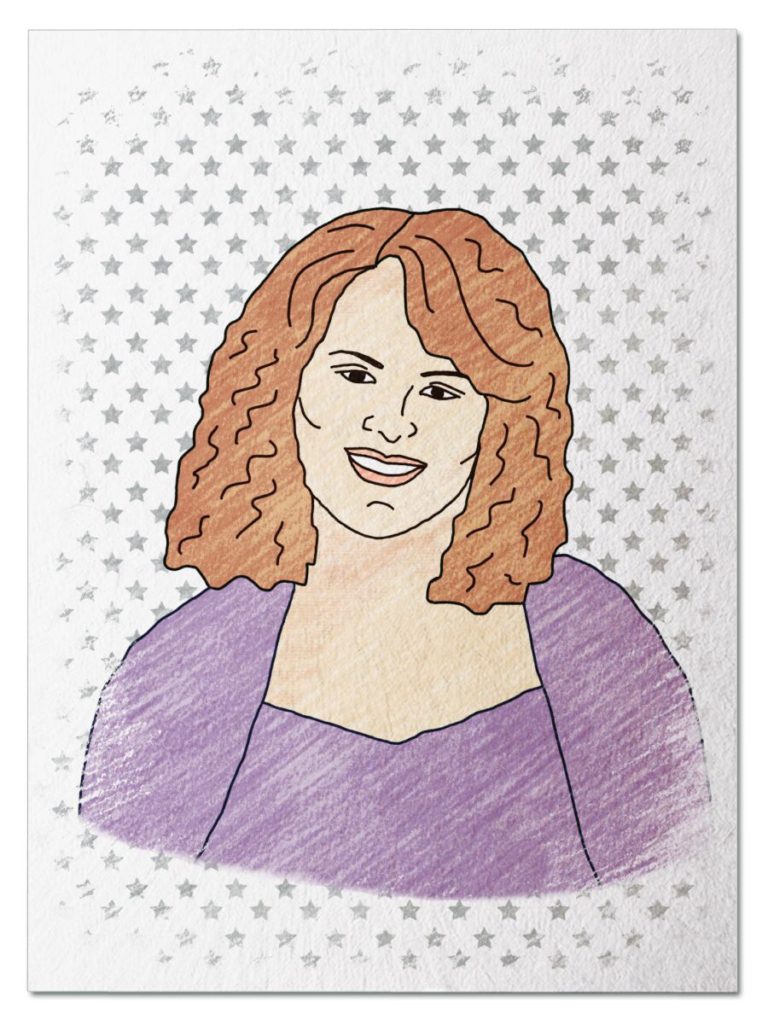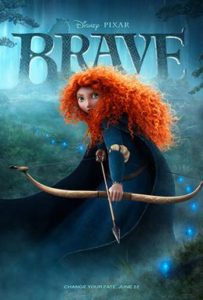
Exceptional Entertainer
As a young girl, she spent as much time as possible reading fairytales and drawing. Before long, she dreamed of a career that merged the two. After graduating from art school with a degree in character animation, she landed her dream job at Disney. After years of hard work in the male-dominated field of animated films, she finally got her chance to direct her own film. Step up to the podium at the 85th Academy Awards in 2013 and meet Brenda Chapman …
Her Ruby Shoe Moment
The Power of the Wand
Her Yellow Brick Road
Brains, Heart & Courage
Glinda’s Gallery
Just the Facts
Her Ruby Shoe Moment
Brenda Chapman was completely shocked as she stepped up to the stage at the 85th Academy Awards. It was February 24, 2013 and the film, Brave, just won the Oscar for Best Animated Feature. Brenda was a director on the film and the first woman to receive an Oscar in the category. At the end of her speech, Brenda thanked her “wonderful, strong, beautiful daughter, Emma,” who was her inspiration for the film.

Brave Theatrical Release Poster (Disney/Pixar Films)
For many years, it was Brenda’s dream to create strong female characters in animated films. She loved the fairytales by Hans Christian Andersen and the Brothers Grimm, and wanted to create a fairy tale that featured a strong, independent girl as the main character. She finally got her chance in 2008 at Pixar Films, when she was named the director of a new film, Brave. She had already been working on the project for a few years, writing the story and conducting research with a team of animators in Scotland.
At the time, Emma was about 5 years old and Brenda struggled to balance both motherhood and her career. The mornings in particular were intense, trying to get Emma ready for school and still making it to work on time. When Brenda got to work, it was difficult at times to shift gears. She thought about Emma and wondered how their relationship would change over the years.
So Brenda decided to channel all her joys and challenges of being a mother into Brave. She modeled the main character, Merida, after her daughter and broke the mould for the standard princess along the way — Merida was a strong willed teenager; she was athletic and loved archery; she was strong and rode horses; her red hair was unruly; she was fiercely independent and a little rebellious; she had a temper; she wanted to pave her own way in the world; and she had a complicated relationship with her mother. In short, Merida was a real character with strengths and weaknesses.

Oscar winners Mark Andrews and Brenda Chapman (Heather Ikei/©AMPAS)
Brenda worked on Brave for 6 years. She wrote most of the story, but was removed from the project in October 2010 before it was completed. The Pixar leadership cited “creative differences” as the reason for replacing Brenda with a new director, Mark Andrews. However, she stayed at Pixar until Brave was released and was credited as one of the directors of the film.
After Brave was released in the summer of 2012, Brenda heard from many fans about how the film touched their lives. She received emails and letters from women and girls about how they saw themselves in Merida or Elinor (or both), as well as how they related to their mother/daughter relationship. In addition, some fans shared how the film inspired them to reach out to family, overcome past differences, and mend relationships. For Brenda, it was very gratifying to learn how the story of Brave, as well as the characters of Merida and Elinor, inspired viewers across America.
The Power of the Wand
Brenda Chapman was one of the first women to break into the male-dominated world of animated film. She also spent much of her career advocating for female characters that go beyond the traditional gender stereotypes. Brenda believed that film studios should move beyond targeting films to either boys or girls. Instead, the goal should be to make films that appeal to all audiences, regardless of gender. Today, The Geena Davis Institute on Gender in Media is a nonprofit organization that advocates for the healthy representation of all people in media, including girls — its logo is “If she can see it, she can be it.”
Her Yellow Brick Road
Brenda started at Walt Disney Animation Studios as a Story Artist in 1988, right after graduation from college. It was the beginning of a new golden age for Disney and Brenda was excited to be part of it. Disney achieved a new level of success by embracing its roots and returning to animated musicals, as well as investing in new technology and computer animation.
 As a story trainee for The Little Mermaid, Brenda wrote dialogue and drew storyboards. She spent hours looking through the archives and sorting through drawings from the first time Disney worked on the story in the 1940s. Many of these drawings were hand painted by women who were pioneers in the industry, and she was inspired by their work.
As a story trainee for The Little Mermaid, Brenda wrote dialogue and drew storyboards. She spent hours looking through the archives and sorting through drawings from the first time Disney worked on the story in the 1940s. Many of these drawings were hand painted by women who were pioneers in the industry, and she was inspired by their work.
Brenda’s hard work paid off and she was hired for a permanent position as a story artist. Her next project was a story artist for Beauty and the Beast — she particularly enjoyed helping to develop the character of Belle and giving her an independent streak. Legend says that she was part of the brainstorming session that resulted in Belle yelling at the Beast for not cooperating when she was trying to dress his wound, a first in Disney history.
After four years of hard work, Brenda was offered a promotion — she became head of the Story Department. She knew it would be a tough job, but couldn’t pass up the opportunity. Brenda’s first project in that role was The Lion King. As head of story, Brenda oversaw all the writers and artists that worked on The Lion King. It was the first original story by Disney in many years, and was originally written as a traditional dialogue-based film. When the decision was made to change the format to an animated musical, Brenda was part of the team that completely re-wrote the story.
 In fall of 1994, Brenda left Disney to work for a new company — DreamWorks Animation Studios. DreamWorks was started a former Disney executive, who recruited her to be in charge of the new story department at DreamWorks. Then, she was asked to take on a bigger role in 1998 as a director for The Prince of Egypt, one of DreamWorks’ first feature films. She reluctantly accepted the position, making her the first woman to direct an animated film for a major Hollywood studio. It was a huge undertaking and eventually two more directors were added to her team. Brenda’s role as director of The Prince of Egypt was a breakthrough for women in the industry.
In fall of 1994, Brenda left Disney to work for a new company — DreamWorks Animation Studios. DreamWorks was started a former Disney executive, who recruited her to be in charge of the new story department at DreamWorks. Then, she was asked to take on a bigger role in 1998 as a director for The Prince of Egypt, one of DreamWorks’ first feature films. She reluctantly accepted the position, making her the first woman to direct an animated film for a major Hollywood studio. It was a huge undertaking and eventually two more directors were added to her team. Brenda’s role as director of The Prince of Egypt was a breakthrough for women in the industry.
Brenda moved to Pixar Studios in 2003, after her daughter, Emma, was born. At the time, she was the only female animator in the Pixar Brian Trust, which oversaw the development of all Pixar films. including Wall-E, Toy Story 2 & 3, and Up. It was a group of talented people who shared their opinions and provided constructive feedback on various Pixar projects. Brenda was usually the only woman in the room during Pixar Brain Trust meetings, however, and found it difficult at times to make her voice heard.
Brains, Heart & Courage
Brenda grew up in rural Illinois. Her four siblings were all quite older than she, so Brenda spent a lot of time alone at times. As a young girl, her favorite activities were reading and drawing. While in high school, Brenda realized that she wanted to incorporate her love of drawing into a career. And her parents supported her decision to study art.
 Brenda considered careers in fashion design and graphic art. But animated films had always captivated her imagination. So she started to pay attention to the credits at the end of the films, and realized that it took a lot of people to create an animated film. The more she thought about it, the more she realized that every frame had to be individually drawn. And she decided she wanted to be involved.
Brenda considered careers in fashion design and graphic art. But animated films had always captivated her imagination. So she started to pay attention to the credits at the end of the films, and realized that it took a lot of people to create an animated film. The more she thought about it, the more she realized that every frame had to be individually drawn. And she decided she wanted to be involved.
Brenda attended Lincoln College and took every art class they offered. She graduated with an Associate of the Arts degree. Then, she went on to the California Institute of the Arts (CalArts), which was the only school in the country that had an animation program at the time. While at CalArts, Brenda developed her art portfolio, which included 3 short films, and hoped her portfolio will help her find a job. Brenda graduated in 1987 with a BFA in character animation — she was one of 5 women in her class.
During the summer after graduation, Brenda applied for a job at Walt Disney Feature Animation. Luckily for her, Disney’s new leadership was looking to hire more women in the story department. During her interview, she was told that would be hired on a 6 week trial basis — if she didn’t prove herself, they would find a new trainee to take her place. Brenda was determined to work hard and earn her place at at Disney.
Glinda’s Gallery
Just the Facts
- Brenda Chapman was born on November 1, 1962 in Beason, Illinois. She was the youngest of 5 children.
- Brenda received an Associate in Art degree from Lincoln College in Lincoln, IL, then Bachelors in Art from California Institute of the Arts in 1987.
- Brenda married Kevin Lima and they have one daughter, Emma.
- While at Walt Disney Animation Studios, Brenda worked on The Rescuers Down Under, The Hunchback of Notre Dame, The Little Mermaid, The Lion King, Beauty and the Beast, Who Framed Roger Rabbit, and Fantasia 2000.
- While at DreamWorks Animation Studios, Brenda worked on The Prince of Egypt, Chicken Run, Sinbad, and Shrek.
- While at Pixar Studios, Brenda worked on Cars, Cars 2, Ratatouille, Wall-E, and Brave.
- Brenda is involved in the Lincoln Film Festival (LFF) in Lincoln, Illinois and the Bay Area International Children’s Film Festival (BAICFF).
Want to Know More?
Holt, Nathalia. Queens of Animation: The Untold Story of the Women Who Transformed the World of Disney and Made Cinematic History. New York: Little, Brown and Company, 2019.
Brenda Chapman, Awards (https://www.imdb.com/name/nm0152312/awards)
Brenda Chapman, Great Women Animators (http://greatwomenanimators.com/brenda-chapman/)
Brenda Chapman Interview Part I (https://www.pixarportal.com/blog/brenda-chapman-interview-part-one-career)
